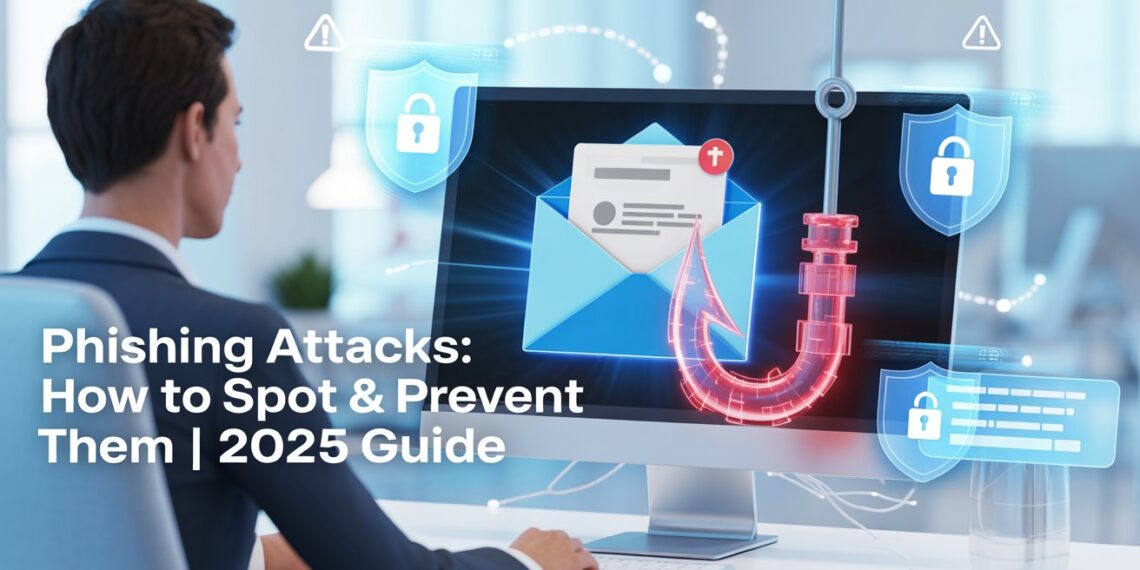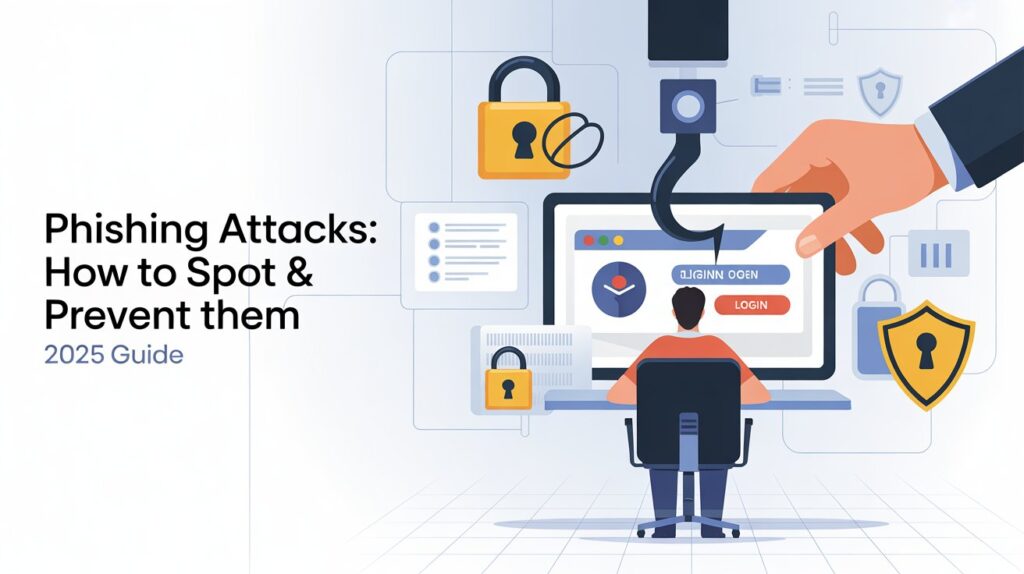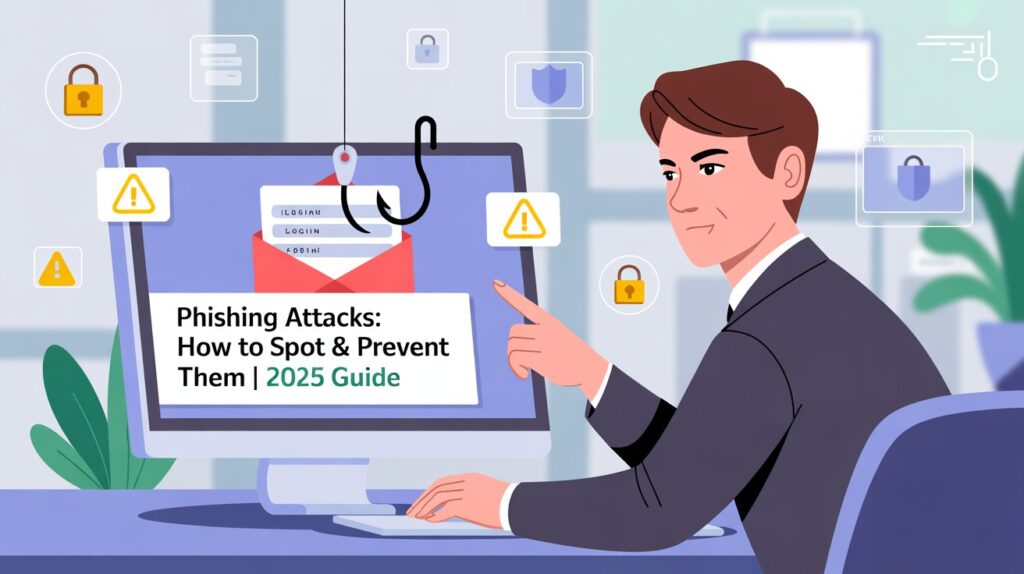In today’s digital world, phishing remains one of the most common—and dangerous—forms of cybercrime. Despite advances in security technology, attackers continue to exploit human psychology to trick individuals and organizations into revealing sensitive information, downloading malware, or transferring money.
This guide on Phishing Attacks: How to Spot & Prevent Them is designed to help you recognize deceptive emails, text messages, and websites, and take practical steps to protect yourself and your organization. Whether you’re a casual internet user, a business owner, or an IT professional, understanding how phishing works is the first line of defense against data breaches and financial loss.
What Is a Phishing Attack?
A phishing attack is a type of social engineering scam where cybercriminals impersonate trusted entities—such as banks, employers, or service providers—to trick victims into revealing confidential data. The goal is often to steal credentials, deploy malware, or gain unauthorized access to systems.
Typically, phishing attacks are carried out through:
-
Email (the most common vector)
-
SMS or text messages (“smishing”)
-
Voice calls (“vishing”)
-
Fake websites designed to mimic legitimate ones
-
Social media messages or ads that contain malicious links
Phishing preys on trust and urgency. Attackers rely on emotional triggers—fear, curiosity, or opportunity—to prompt quick reactions before users can spot the red flags.
Common Types of Phishing Attacks
Understanding the variations of phishing helps you identify the threat faster. Here are the most prevalent types:
1. Email Phishing
Attackers send mass emails that appear to come from reputable companies. These messages often contain links to fake websites that capture login credentials or prompt downloads of malicious attachments.
2. Spear Phishing
Unlike generic phishing emails, spear phishing is highly targeted. Cybercriminals research the victim—such as a company executive or finance employee—to craft a personalized message that looks authentic.
3. Whaling
Whaling targets senior executives or decision-makers (“big fish”) within an organization. The stakes are higher, and the attackers’ goal often involves large financial transactions or access to sensitive corporate systems.
4. Business Email Compromise (BEC)
In BEC schemes, attackers spoof or hijack legitimate business accounts to instruct employees or partners to transfer funds or share confidential information.
5. Smishing and Vishing
Smishing uses text messages, while vishing uses phone calls to trick users into revealing data or clicking malicious links. These are increasingly common due to the rise of mobile communication.
6. Clone Phishing
A genuine message that a user previously received is “cloned” by an attacker, who resends it with a malicious link or attachment, making it appear even more trustworthy.
How to Spot a Phishing Attempt
Recognizing phishing attempts can save you from devastating consequences. Here’s what to look for:
1. Suspicious Sender Address
Phishing emails often come from addresses that mimic legitimate domains but with subtle differences—like “[email protected]” instead of “[email protected].” Always verify the sender’s email domain before clicking any link.
2. Urgent or Threatening Language
Messages that claim your account will be suspended, your payment failed, or your password expired are designed to create panic. Be cautious when urgency is used to force quick action.
3. Unexpected Attachments or Links
Be wary of attachments or embedded links you weren’t expecting. Hover over links to check the actual destination URL before clicking.
4. Generic Greetings
Legitimate organizations typically address you by name. Phrases like “Dear Customer” or “Dear User” may signal a phishing attempt.
5. Spelling and Grammar Mistakes
Poor grammar, awkward phrasing, or inconsistent branding are common indicators of fraudulent messages.
6. Requests for Sensitive Information
Reputable companies never ask for passwords, PINs, or financial data via email. Any such request should raise immediate suspicion.
7. Unusual Sender Requests
If a message asks you to perform an unfamiliar task, such as buying gift cards or transferring funds, always verify through another communication channel.
Real-World Example: The Payroll Scam
In a recent phishing incident, HR staff at a mid-sized company received an email that appeared to come from the CEO requesting changes to an employee’s direct deposit information. The email looked authentic, complete with the CEO’s name and company logo. However, the “reply-to” address led to a fake domain.
The result? The attacker diverted payroll funds for two months before detection. This case underscores the importance of verifying all unusual financial requests, even when they appear legitimate.
The Anatomy of a Phishing Email
Let’s break down the key components of a typical phishing email:
-
From Field – Often a spoofed or lookalike address.
-
Subject Line – Uses urgency (“Account Locked!” or “Invoice Overdue”).
-
Body Content – Claims there’s an issue needing immediate attention.
-
CTA Button or Link – Directs you to a fake login page.
-
Signature or Branding – Includes copied logos or disclaimers to add legitimacy.
Knowing these elements helps you analyze suspicious emails more confidently.
Preventing Phishing Attacks
Defense against phishing requires both awareness and layered security. Here’s how to protect yourself and your organization.
1. Enable Multi-Factor Authentication (MFA)
Even if attackers steal your password, MFA adds an extra layer—requiring a code, token, or biometric confirmation before access is granted.
2. Verify URLs Before Clicking
Hover over links to view the destination URL. If it looks suspicious or doesn’t match the sender’s domain, don’t click it.
3. Keep Software Updated
Regularly update operating systems, browsers, and antivirus tools. Outdated software often contains vulnerabilities that attackers exploit.
4. Use Advanced Email Filters
Business-grade email gateways and spam filters can block many phishing attempts before they reach your inbox.
5. Conduct Regular Employee Training
For organizations, regular phishing awareness training helps employees recognize and report suspicious messages. Simulated phishing exercises can significantly reduce risk.
6. Implement SPF, DKIM, and DMARC
These authentication protocols prevent email spoofing by verifying that messages come from authorized servers.
7. Never Share Sensitive Information via Email
Always use secure portals or verified communication channels for sensitive data exchange.
8. Back Up Your Data
If a phishing attempt leads to ransomware or data loss, backups ensure business continuity.
What to Do If You Fall Victim to a Phishing Attack
Even the most cautious users can occasionally make mistakes. If you suspect you’ve clicked a phishing link or shared sensitive data, act quickly:
-
Disconnect from the Internet to prevent further data transmission.
-
Change all affected passwords immediately, starting with your email and financial accounts.
-
Enable MFA if not already in place.
-
Run a full antivirus or anti-malware scan to remove potential infections.
-
Contact your IT or security team if it’s a corporate account.
-
Notify your bank or service provider to monitor suspicious activity.
-
Report the phishing email to your email provider and relevant authorities (for example, in the UK, forward to [email protected]; in the US, to [email protected]).
Taking swift action limits the damage and helps authorities track ongoing campaigns.
Phishing Prevention for Businesses
Organizations face heightened phishing risks due to the potential for large-scale data breaches. Business leaders should adopt a multi-layered defense strategy:
1. Establish a Security Policy
Define clear rules on handling suspicious emails, reporting incidents, and verifying financial transactions.
2. Conduct Regular Awareness Training
Simulated phishing campaigns teach employees to recognize and resist social engineering.
3. Implement Role-Based Access Control
Limit user permissions to only what’s necessary. This reduces exposure if credentials are compromised.
4. Use Endpoint Detection and Response (EDR)
EDR solutions detect and respond to suspicious activities in real time.
5. Monitor for Domain Spoofing
Use tools to detect fake domains or lookalike websites impersonating your brand.
6. Enforce Strong Password Policies
Encourage complex, unique passwords and consider deploying password managers across the organization.
The Evolving Nature of Phishing
Phishing tactics continue to evolve. Attackers now use AI-generated messages, deepfake voices, and cloned websites that are nearly indistinguishable from legitimate ones. Advanced spear phishing, or “socially engineered phishing,” uses publicly available data to craft convincing lures.
To stay ahead, individuals and businesses must combine user awareness, technology controls, and continuous vigilance.
FAQs About Phishing Attacks
1. What is the main goal of a phishing attack?
The goal is to trick victims into revealing sensitive information, such as passwords, credit card numbers, or business credentials, often leading to identity theft or financial fraud.
2. Can antivirus software stop phishing?
Antivirus tools can detect malicious attachments or websites, but they cannot stop social engineering. User awareness remains essential.
3. How often should companies train employees on phishing?
At least twice a year. Frequent, short awareness sessions or phishing simulations work best.
4. How do I report a phishing email?
Forward the email to your organization’s IT security team or relevant national reporting centers (e.g., [email protected] or [email protected]).
5. Are text messages also used for phishing?
Yes. “Smishing” messages can contain malicious links or phone numbers designed to steal information from your mobile device.
Conclusion
Phishing remains a persistent threat because it targets human behavior rather than just technology. By learning how to recognize the warning signs, verifying every communication, and adopting layered security practices, you can significantly reduce your risk.
Whether you’re an individual or managing an organization, the key to protection lies in awareness, vigilance, and timely action.
Understanding Phishing Attacks: How to Spot & Prevent Them isn’t just about avoiding one bad email—it’s about building a mindset that prioritizes cybersecurity in every digital interaction.












